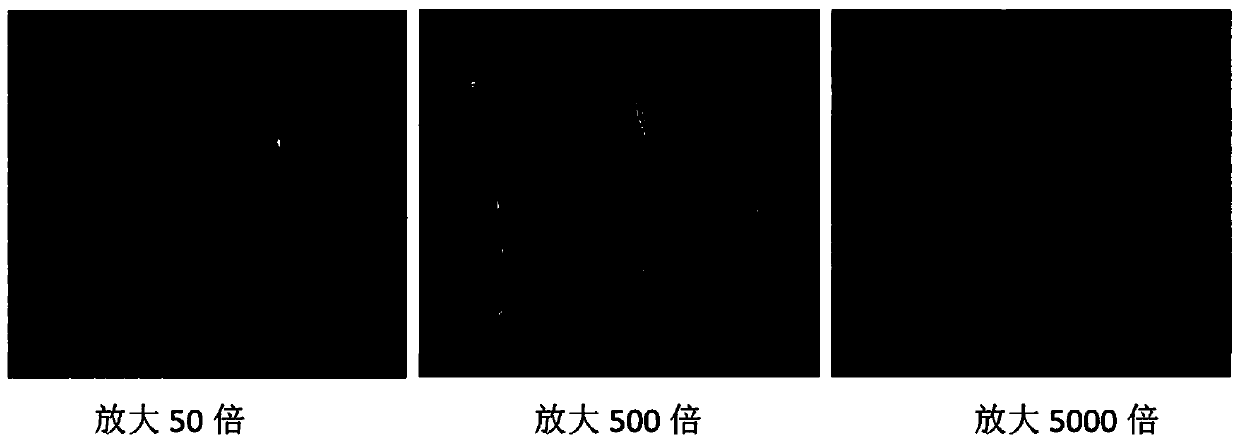Stainless steel electrolytic passivator, preparation method and application thereof
An electrolytic passivation, stainless steel technology, applied in the direction of anodic oxidation, etc., can solve the problems that the service life of stainless steel products cannot be greatly improved, the service life of stainless steel products is reduced, and the environmental protection requirements are not met, so as to reduce the efficiency of electrolytic passivation , improve the service life and avoid the effect of heavy metal pollution
- Summary
- Abstract
- Description
- Claims
- Application Information
AI Technical Summary
Problems solved by technology
Method used
Image
Examples
Embodiment 1
[0035] A stainless steel electrolytic passivator, comprising the following raw materials in parts by weight:
[0036]
[0037]
[0038] Described sulfuric acid is the concentrated sulfuric acid that mass fraction is 98%.
[0039] The corrosion inhibitor is prepared by mixing thiourea derivatives, polyaspartic acid and molybdate in a weight ratio of 0.2:1:0.7.
[0040] The molybdate is formed by mixing sodium molybdate, ammonium molybdate and potassium molybdate in a weight ratio of 2:0.7:0.8.
[0041] The thiourea derivative is formed by mixing methylthiourea and lauroylthiourea at a weight ratio of 1.5:2.5.
[0042] The wetting agent is polyethylene glycol, and the polyethylene glycol is composed of PEG-600 and PEG-400 in a weight ratio of 2:4.
[0043] The stainless steel electrolytic passivator also includes 2 parts by weight of sulfamic acid and 0.3 parts by weight of propylene glycol.
[0044] The above-mentioned preparation method of the stainless steel electrol...
Embodiment 2
[0049] A stainless steel electrolytic passivator, comprising the following raw materials in parts by weight:
[0050]
[0051] Described sulfuric acid is the concentrated sulfuric acid that mass fraction is 93%.
[0052] The corrosion inhibitor is formed by mixing thiourea derivatives, polyaspartic acid and molybdate in a weight ratio of 0.1:0.5:0.5.
[0053] The molybdate is formed by mixing sodium molybdate, ammonium molybdate and potassium molybdate in a weight ratio of 1:0.5:0.5.
[0054] The thiourea derivative is formed by mixing methylthiourea and lauroylthiourea at a weight ratio of 1:2.
[0055] The stainless steel electrolytic passivator also includes 1 weight part of sulfamic acid.
[0056] The preparation method of the above-mentioned stainless steel electrolytic passivator comprises the following steps: weighing each raw material by weight; under the condition of continuous stirring, adding sulfuric acid to the water, controlling the temperature at 20-30°C, t...
Embodiment 3
[0061] A stainless steel electrolytic passivator, comprising the following raw materials in parts by weight:
[0062]
[0063] Described sulfuric acid is the concentrated sulfuric acid that mass fraction is 98%.
[0064] The corrosion inhibitor is formed by mixing thiourea derivatives, polyaspartic acid and molybdate in a weight ratio of 0.4:1.5:3.
[0065] The molybdate is formed by mixing sodium molybdate, ammonium molybdate and potassium molybdate in a weight ratio of 3:1:1.
[0066] The thiourea derivative is formed by mixing methylthiourea and lauroylthiourea at a weight ratio of 2:3.
[0067] The wetting agent is polyethylene glycol, and the polyethylene glycol is composed of PEG-600 and PEG-400 in a weight ratio of 2:5.
[0068] The stainless steel electrolytic passivator also includes 3 parts by weight of sulfamic acid and 0.6 parts by weight of propylene glycol.
[0069] The above-mentioned preparation method of the stainless steel electrolytic passivator compri...
PUM
 Login to View More
Login to View More Abstract
Description
Claims
Application Information
 Login to View More
Login to View More - R&D Engineer
- R&D Manager
- IP Professional
- Industry Leading Data Capabilities
- Powerful AI technology
- Patent DNA Extraction
Browse by: Latest US Patents, China's latest patents, Technical Efficacy Thesaurus, Application Domain, Technology Topic, Popular Technical Reports.
© 2024 PatSnap. All rights reserved.Legal|Privacy policy|Modern Slavery Act Transparency Statement|Sitemap|About US| Contact US: help@patsnap.com










